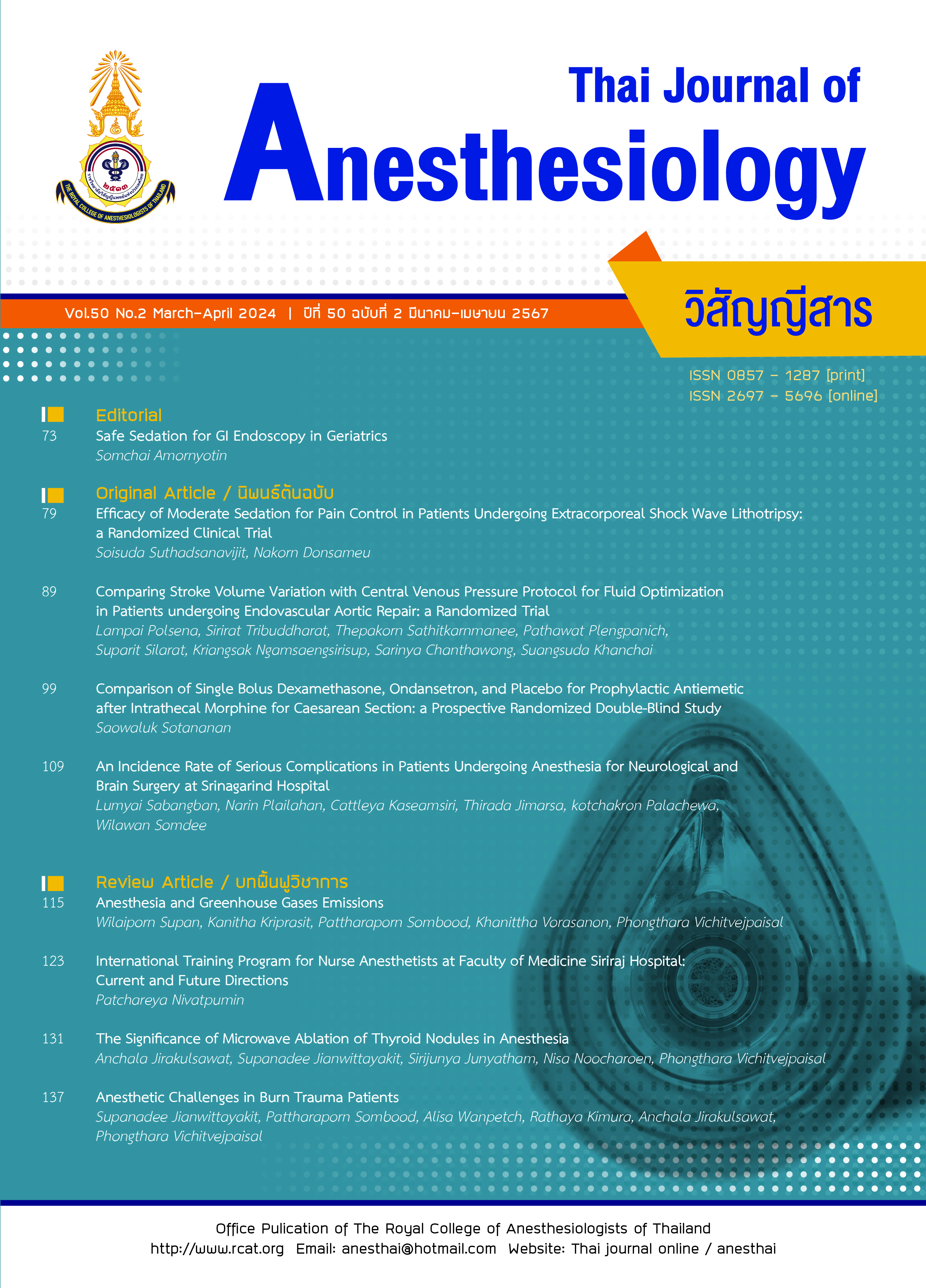An Incidence Rate of Serious Complications in Patients Undergoing Anesthesia for Neurological and Brain Surgery at Srinagarind Hospital
Main Article Content
Abstract
Introduction: Surgery is one the main management for neurological and brain disorders. Patients with such conditions undergo surgery and general anesthesia. However, these procedures come with potential complications that can significantly impact patient outcomes. This study aims to analyze severe complications while also identify opportunities for improving clinical practices and enhancing patient care quality. Methods: Data collected from patients who underwent neurosurgery and received anesthesia at Srinagarind Hospital between January and December 2021 were retrospectively analyzed. The data included demographics and severe complications. Results: There were 1,225 cases who underwent neurosurgical anesthesia. Most of them had a Glasgow coma score over 8. Most surgeries lasted less than or equal to 6 hours. Craniotomy was the most common type of procedure. Most cases did not receive blood transfusion. General anesthesia (balanced inhalation technique) was predominantly used. Most cases had endotracheal tube retained during transferring to intensive care unit or ward. Severe complications occurred in 7 cases (0.6%). These included brain edema, severe arrhythmia, reintubation, severe hypothermia, and severe postoperative nausea/vomiting. No death was identified. The incidence was lower than the previous year. Conclusion: The incidence of severe complications in this study was 0.6%. The incidents include brain edema, severe arrhythmia, reintubation, severe hypothermia, and severe PONV. This incidence decreases compared to the previous years’ data. The utilization of clinical practice guidelines specific to this patient population has proven beneficial in addressing these issues proactively, and physicians can effectively manage and emphasize the patient safety.
Article Details

This work is licensed under a Creative Commons Attribution-NonCommercial-NoDerivatives 4.0 International License.
References
ภาควิชาวิสัญญีวิทยา. รายงานอุบัติการณ์ภาควิชาฯ การทำ RCA. ภาควิชาวิสัญญีวิทยา คณะแพทยศาสตร์ มหาวิทยาลัยขอนแก่น. 2563-2564.
Priebe HJ. Aneurysmal subarachnoid haemorrhage and the anaesthetist. Br J Anaesth. 2007;99:102-18.
ธิดา เอื้อกฤดาธิการ. การให้ยาระงับความรู้สึกในผู้ป่วยที่มารับการผ่าตัดทางสมอง. ค้นเมื่อ 1 กุมภาพันธ์ 2565. จาก http://medinfo2.psu.ac.th/anesth/New%201511/neuro_Anes.pdf
Lonjaret L, Guyonnet M, Berard E, et al. Postoperative complications after craniotomy for brain tumor surgery. Anaesth Crit Care Pain Med. 2017;36:213-8.
Pruitthithada S, Hoontanee N, Duriyaprapan P, Ittichaikulthol W. Incidence and associated factors of postoperative nausea and vomiting in patients undergoing craniotomy. J Dept Med Sci. 2019:44:114-9.
สุนีย์ ศรีสว่าง, จตุพงษ์ พันธ์วิไล, ศักดิ์ระพี ชัยอินทรีอาจ. อุบัติการณ์การเกิดภาวะแทรกซ้อนทางวิสัญญี โรงพยาบาลประสาทเชียงใหม่ ปีงบประมาณ 2557-2559. วารสารกรมการแพทย์. 2561;43:106-11.
ขนิษฐา พันธ์สุวรรณ, นิ่มนวล มันตราภรณ์. การพัฒนาแนวปฏิบัติการพยาบาลสำหรับการระงับความรู้สึกแบบทั่วไปในผู้ป่วยผ่าตัดหนีบหลอดเลือดโป่งพองในสมองในโรงพยาบาลเจ้าพระยายมราช. วารสารการพยาบาลและดูแลสุขภาพ. 2558;33:154-65.
ขวัญเรือน สิงห์กวาง. การพัฒนาแนวปฏิบัติการประเมินสัญญาณเตือนของภาวะความดันในกะโหลกศีรษะสูงในผู้ป่วยหลังผ่าตัดเนื้องอกสมอง. พุทธชินราชเวชสาร. 2563;37:136-48.
จตุรดา จริยารัตนกูล. ประสิทธิผลของการใช้แนวปฏิบัติการพยาบาลสำหรับการให้ความรู้เพื่อลดความวิตกกังวลในผู้สูงอายุก่อนเข้ารับการผ่าตัดใหญ่ โรงพยาบาลมหาราชนครเชียงใหม่. ค้นเมื่อ สิงหาคม 2565, จาก http://repository.cmu.ac.th/handle/6653943832/39907
Titler MG, Kleber C, Steelman VJ, et al. The IOWA model of evidence-based practice to promote quality care. Crit Care Nurs Clin North Am. 2001;13:497-509.
Advanced trauma life support. [monograph on the internet]. 2022 [cited 2022 Aug 12]. Available from: https://www.facs.org/quality-programs/trauma/education/advanced-trauma-life-support/?page=1
Powers WJ, Rabinstein AA, Ackerson T, et al. 2018 Guidelines for the early management of patients with acute ischemic stroke: a guideline for healthcare professionals from the American Heart Association /American Stroke Association. Stroke. 2018;49:e46-99.
Kurland DB, Khaladj-Ghom A, Stokum JA, et al. Complications associated with decompressive craniectomy: a systematic review. Neurocrit Care. 2015;23:292-304.
Chowdhury T, Petropolis A, Cappellani RB. Cardiac emergencies in neurosurgical patients. Biomed Res Int. 2015;2015:751320.
Shalev D, Kamel H. Risk of reintubation in neurosurgical patients. Neurocrit Care. 2015;22:15-9.
Uribe AA, Stoicea N, Echeverria-Villalobos M, et al. Postoperative nausea and vomiting after craniotomy: an evidence-based review of general considerations, risk factors, and management. J Neurosurg Anesthesiol. 2021;33:212-20.


